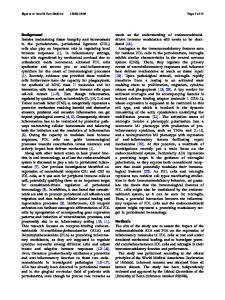Specific shifts in the endocannabinoid system in hibernating brown bears
- PDF / 1,469,015 Bytes
- 13 Pages / 595.276 x 790.866 pts Page_size
- 39 Downloads / 362 Views
RESEARCH
Open Access
Specific shifts in the endocannabinoid system in hibernating brown bears Christian Boyer1, Laura Cussonneau1, Charlotte Brun2, Christiane Deval1, Jean-Paul Pais de Barros3, Stéphanie Chanon4, Nathalie Bernoud-Hubac4, Patricia Daira4, Alina L. Evans5, Jon M. Arnemo5,6, Jon E. Swenson7, Guillemette Gauquelin-Koch8, Chantal Simon4, Stéphane Blanc2, Lydie Combaret1, Fabrice Bertile2† and Etienne Lefai1*†
Abstract In small hibernators, global downregulation of the endocannabinoid system (ECS), which is involved in modulating neuronal signaling, feeding behavior, energy metabolism, and circannual rhythms, has been reported to possibly drive physiological adaptation to the hibernating state. In hibernating brown bears (Ursus arctos), we hypothesized that beyond an overall suppression of the ECS, seasonal shift in endocannabinoids compounds could be linked to bear’s peculiar features that include hibernation without arousal episodes and capacity to react to external disturbance. We explored circulating lipids in serum and the ECS in plasma and metabolically active tissues in freeranging subadult Scandinavian brown bears when both active and hibernating. In winter bear serum, in addition to a 2-fold increase in total fatty acid concentration, we found significant changes in relative proportions of circulating fatty acids, such as a 2-fold increase in docosahexaenoic acid C22:6 n-3 and a decrease in arachidonic acid C20:4 n6. In adipose and muscle tissues of hibernating bears, we found significant lower concentrations of 2arachidonoylglycerol (2-AG), a major ligand of cannabinoid receptors 1 (CB1) and 2 (CB2). Lower mRNA level for genes encoding CB1 and CB2 were also found in winter muscle and adipose tissue, respectively. The observed reduction in ECS tone may promote fatty acid mobilization from body fat stores, and favor carbohydrate metabolism in skeletal muscle of hibernating bears. Additionally, high circulating level of the endocannabinoid-like compound N-oleoylethanolamide (OEA) in winter could favor lipolysis and fatty acid oxidation in peripheral tissues. We also speculated on a role of OEA in the conservation of an anorexigenic signal and in the maintenance of torpor during hibernation, while sustaining the capacity of bears to sense stimuli from the environment. Keywords: Hibernation, Brown bear, Metabolism, Lipidomic, Docosahexaenoic acid, Endocannabinoid system, Cannabinoid receptor 1, Cannabinoid receptor 2, 2-arachidonoylglycerol, Anandamide, N-oleoylethanolamide
Background To deal with seasonal cold and food shortage during winter, hibernating mammals show a combination of behavioral and physiological changes. To save energy during hibernation, hibernating animals use periods of torpor characterized by decreased metabolic rate and body * Correspondence: [email protected] † Fabrice Bertile and Etienne Lefai contributed equally to this work. 1 Université Clermont Auvergne, INRAE, UNH, Clermont-Ferrand, France Full list of author information is available at the end of the article
Data Loading...











